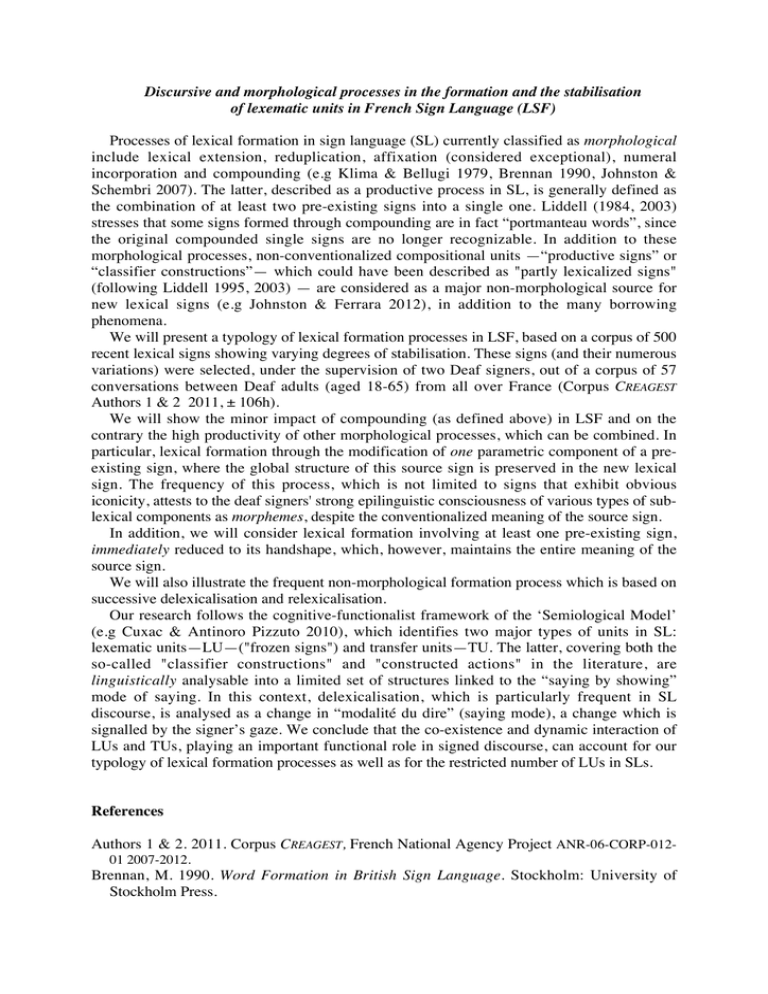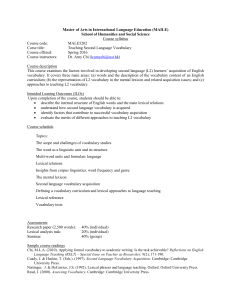Discursive and morphological processes in the formation and the stabilisation
advertisement

Discursive and morphological processes in the formation and the stabilisation of lexematic units in French Sign Language (LSF) Processes of lexical formation in sign language (SL) currently classified as morphological include lexical extension, reduplication, affixation (considered exceptional), numeral incorporation and compounding (e.g Klima & Bellugi 1979, Brennan 1990, Johnston & Schembri 2007). The latter, described as a productive process in SL, is generally defined as the combination of at least two pre-existing signs into a single one. Liddell (1984, 2003) stresses that some signs formed through compounding are in fact “portmanteau words”, since the original compounded single signs are no longer recognizable. In addition to these morphological processes, non-conventionalized compositional units —“productive signs” or “classifier constructions”— which could have been described as "partly lexicalized signs" (following Liddell 1995, 2003) — are considered as a major non-morphological source for new lexical signs (e.g Johnston & Ferrara 2012), in addition to the many borrowing phenomena. We will present a typology of lexical formation processes in LSF, based on a corpus of 500 recent lexical signs showing varying degrees of stabilisation. These signs (and their numerous variations) were selected, under the supervision of two Deaf signers, out of a corpus of 57 conversations between Deaf adults (aged 18-65) from all over France (Corpus CREAGEST Authors 1 & 2 2011, ± 106h). We will show the minor impact of compounding (as defined above) in LSF and on the contrary the high productivity of other morphological processes, which can be combined. In particular, lexical formation through the modification of one parametric component of a preexisting sign, where the global structure of this source sign is preserved in the new lexical sign. The frequency of this process, which is not limited to signs that exhibit obvious iconicity, attests to the deaf signers' strong epilinguistic consciousness of various types of sublexical components as morphemes, despite the conventionalized meaning of the source sign. In addition, we will consider lexical formation involving at least one pre-existing sign, immediately reduced to its handshape, which, however, maintains the entire meaning of the source sign. We will also illustrate the frequent non-morphological formation process which is based on successive delexicalisation and relexicalisation. Our research follows the cognitive-functionalist framework of the ‘Semiological Model’ (e.g Cuxac & Antinoro Pizzuto 2010), which identifies two major types of units in SL: lexematic units—LU—("frozen signs") and transfer units—TU. The latter, covering both the so-called "classifier constructions" and "constructed actions" in the literature, are linguistically analysable into a limited set of structures linked to the “saying by showing” mode of saying. In this context, delexicalisation, which is particularly frequent in SL discourse, is analysed as a change in “modalité du dire” (saying mode), a change which is signalled by the signer’s gaze. We conclude that the co-existence and dynamic interaction of LUs and TUs, playing an important functional role in signed discourse, can account for our typology of lexical formation processes as well as for the restricted number of LUs in SLs. References Authors 1 & 2. 2011. Corpus CREAGEST, French National Agency Project ANR-06-CORP-01201 2007-2012. Brennan, M. 1990. Word Formation in British Sign Language. Stockholm: University of Stockholm Press. Cuxac, C., & Antinoro Pizzuto, E. 2010. Emergence, norme et variation dans les langues des signes : vers une redéfinition notionnelle. In B. Garcia et M. Derycke (eds), Sourds et langue des signes. Norme et variations, Langage et Société 131, Maison des Sciences de l’Homme, Paris, 37-53. Johnston, T., & Ferrara, L. 2012. Lexicalization in signed languages: when is an idiom not an idiom? Selected Papers from the 3rd UK Cognitive Linguistics Conference, University of Hertfordshire: 6-8 July 2010. http://uk-cla.org.uk/proceedings Vol 1: 229-248 Johnston, T., & Schembri, A. 2007. Australian Sign Language (Auslan): An introduction to sign language linguistics. Cambridge: Cambridge University Press. Klima, E. S., & Bellugi, U. 1979. The Signs of Language. Cambridge, MA: Harvard University Press. Liddell, Scott K. 1984. THINK and BELIEVE: Sequentiality in American Sign Language signs, Language 60.2: 372-399. Liddell, Scott K. 1995. Real, surrogate, and token space: Grammatical consequences in ASL. In Karen Emmorey and Judy Reilly (eds), Language, Gesture, and Space. Hillsdale, NJ: Lawrence Erlbaum Associates, 19-41. Liddell, Scott K. 2003. Grammar, Gesture, and Meaning in American Sign Language. Cambridge, Cambridge University Press








